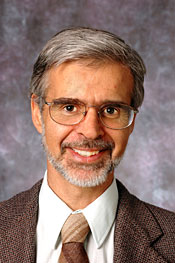Jan 21 2011
Dozens of researchers have gathered at UT Dallas this week to focus on ways nanotechnology can address challenging energy-related problems.
Sponsored by the U.S. Department of Energy and the UT Dallas Institute for Intelligent Energy Systems, the meeting involves members of the Computational Materials and Chemical Sciences Network (CMCSN), which fosters collaboration by groups at a variety of institutions on energy-related research projects.
 Dr. Yves Chabal says conference attendees will be discussing ideas that could play important roles in future energy technology.
Dr. Yves Chabal says conference attendees will be discussing ideas that could play important roles in future energy technology.
CMCSN has five collaborative research teams that each consist of up to 40 scientists from various institutions organized around a central scientific objective of key importance to both the field of materials science and the Department of Energy. This week’s meeting involves the efforts of one of those groups, which is addressing “predictive modeling of the growth and properties of energy-relevant thin films and nanostructures.”
Specific topics will include various aspects of technology supporting next-generation semiconductors, batteries and solar cells. Three days of presentations are taking place through Jan. 22 with participants from the University of Maryland, Georgia Tech, Princeton University, Sandia National Laboratories, Penn State, Rice University, Harvard University, UT Dallas and elsewhere.
“These meetings are an important means to foster collaboration in areas that could have a significant impact on future energy technology,” said Dr. Yves Chabal, head of materials science and engineering at UT Dallas and holder of the Texas Instruments Distinguished University Chair in Nanoelectronics.
Chabal also chairs the research team’s scientific committee, which includes Dr. Robert Helms, director of the Institute for Intelligent Energy Systems; Dr. K.J. Cho, an associate professor of materials science and engineering at UT Dallas; and researchers from Rutgers University, Iowa State University, the Department of Energy’s Ames Laboratory and the University of Tennessee.
The CMCSN’s other four collaborative teams are addressing:
- Resonant inelastic X-ray scattering.
- Structure and dynamics of water and aqueous solutions.
- Computational design of iron-based superconductors.
- Disorder-mediated properties of functional materials.
Source: http://www.utdallas.edu/